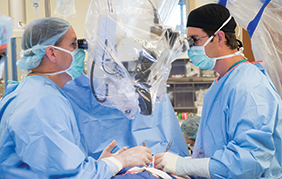Surgical options
Early-stage lung cancer is often treated with the surgical removal of part or all of the affected lung.
However, many lung cancers are not detected until a tumor has spread within the chest. As a result, for many patients at City of Hope, lung cancer surgery may be used in combination with chemotherapy, radiation therapy and interventional pulmonology treatments.
Our surgeons perform four types of surgery to treat lung cancer:
Lobectomy
In this procedure, an entire lobe is removed from your lung. (The right lung has three lobes. The left lung has two lobes.)
Pneumonectomy
This is the removal of an entire lung.
Segmentectomy
This surgery is designed to remove cancerous tissue from a lung segment when a lobectomy cannot be performed. The lungs have various numbers of segments: three in the right upper love, tow in the right middle lobe, five in the right lower lobe, four in the left lower lobe and four in the left upper lobe.
Wedge resection
This procedure is used to remove cancerous tissue from your lung, typically in diagnosing or treating metastasis.
Two of the surgical approaches used at City of Hope include:
Robotic surgery (da Vinci® surgical system)
The da Vinci surgical system offers a minimally invasive alternative to open surgery and laparoscopy. For lung cancer patients, robotic surgery is performed through a few tiny incisions between your ribs, thus avoiding the necessity of a large incision or movement of the ribs. The tiny incisions and a less invasive approach may help you return to normal activities more quickly.
Video-assisted thoracic surgery (VATS)
VATS is a minimally invasive technology used to perform a lobectomy or wedge resection without opening your chest. This thoracotomy procedure involves inserting a long, thin tube with an attached camera (called a thorascope) into your chest. Guided by images from the camera, the surgeon removes portions of the lung that contain cancerous tissues. VATS typically offers a quicker recovery time and less pain than other types of lung surgery.
